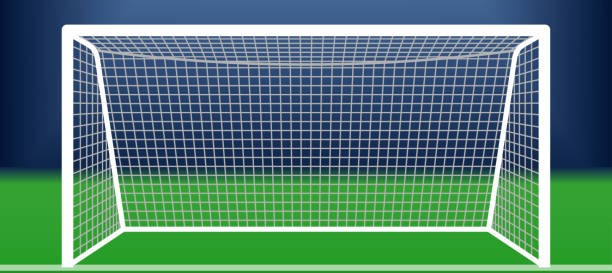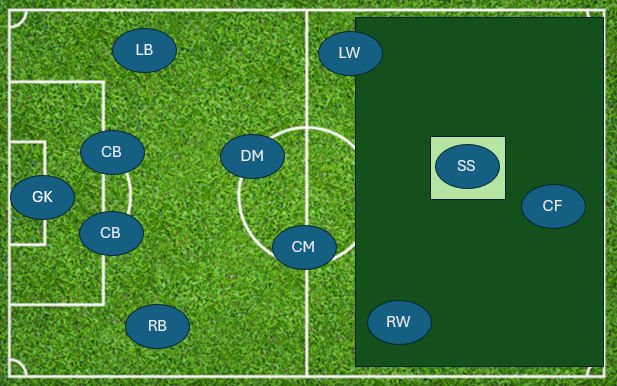













THE SECOND STRIKER.

The second striker (also known as a support striker or shadow striker) is a forward player in football
who operates just behind the main striker, blending goal-scoring and playmaking duties. This position requires versatility,
as the second striker supports the primary striker but also drops deeper to create chances for others. Here’s an in-depth
explanation of the second striker's role and responsibilities:
Positioning:
- ▫ BEHIND THE MAIN STRIKER: The second striker typically plays in the space between the main striker and the midfield.
This player is often positioned slightly deeper than the center forward, giving them more freedom to roam and find space.
- ▫ CENTRAL ROLE: While primarily positioned centrally, a second striker can drift wide or drop into midfield to
create overloads or to escape tight marking.
- ▫ LINK BETWEEN MIDFIELD AND ATTACK: The second striker often bridges the gap between the midfield and the attack,
receiving passes from midfielders and linking up with the primary striker or wingers.
Role and Responsibilities:
- ▫ GOAL SCORING: The second striker is a key attacking player and is expected to score goals, though not necessarily
as many as the main striker. They take advantage of the spaces created by the primary striker, often pouncing on rebounds,
through balls, or second balls.
- ▫ PLAYMAKING: A significant responsibility of the second striker is to create chances for teammates, especially the
primary striker. This involves delivering key passes, through balls, and crosses to set up goal-scoring opportunities.
- ▫ SUPPORT TO MAIN STRIKER: The second striker assists the main forward by providing an additional offensive outlet,
drawing defenders away, and making runs into dangerous areas.
- ▫ LINK-UP PLAY: The second striker must have excellent ball control and passing ability to combine effectively with midfielders
and the main striker. Quick one-two passes, dribbling into space, and intelligent positioning are crucial in their role.
Movement and Space Exploitation:
- ▫ ROAMING: Unlike a traditional striker who is more focused on staying up top, the second striker has more freedom to roam across
the pitch. They can drift into wider areas, drop into midfield, or find gaps between the opponent's defense and midfield lines.
- ▫ OFF-THE-BALL MOVEMENT: The second striker’s movement off the ball is critical. By making late runs into the box or pulling defenders
out of position, they create space for the main striker or attacking midfielders to exploit.
- ▫ OPERATING IN THE HALF-SPACES: The second striker often operates in the "half-spaces," which are the areas between the central
and wide channels of the field. This positioning allows them to link up with wingers, midfielders, and the main striker.
Pressing and Defensive Work:
- ▫ DEFENSIVE RESPONSIBILITIES: In modern football, second strikers are often tasked with helping to press the opposition’s midfield
or defenders when their team does not have the ball. This high pressing can disrupt the opponent’s build-up play and force mistakes.
- ▫ DROPPING INTO MIDFIELD: When defending, the second striker might drop deeper to help the midfield, adding numbers and covering
passing lanes.
Tactical Variations:
- ▫ 4-4-2 FORMATION: In this classic two-striker system, the second striker plays alongside the main striker but drops deeper or
drifts wide to help create attacking opportunities.
- ▫ 4-4-1-1 FORMATION: This setup places the second striker behind the main striker, with the second striker acting as a link between
the midfield and the lone forward. They are responsible for playmaking and arriving late in the box for scoring opportunities.
- ▫ 3-5-2 FORMATION: In this setup, the second striker partners with the main striker but has more freedom to drop into midfield or
pull wide to link up with wing-backs or attacking midfielders.
Skills and Attributes:
- ▫ CREATIVITY: The second striker needs to be a creative player capable of finding gaps in the opponent's defense and delivering
key passes or assists to the main striker and other attacking players.
- ▫ FINISHING: While not the primary goal-scorer, the second striker must be adept at finishing, especially in and around the penalty box.
They need to capitalize on chances created by the main striker or midfielders.
- ▫ DRIBBLING: Good dribbling ability is essential for a second striker. They need to be able to take on defenders, create space,
and maneuver in tight areas to open up passing or shooting opportunities.
- ▫ PASSING AND VISION: The second striker is often relied upon to create chances. They must have excellent vision to spot runs by
teammates and the technical ability to deliver through balls, crosses, and quick combinations.
- ▫ TACTICAL AWARENESS: The second striker must be tactically astute, understanding when to drop deeper to help the midfield or
when to make runs into the box to support the main striker.
Difference Between a Second Striker and a Traditional Striker:
- ▫ POSITIONING: While a traditional striker often stays high up the pitch and focuses primarily on finishing, the second striker
operates in a deeper role, blending attacking and playmaking responsibilities.
- ▫ SUPPORT ROLE: The second striker's job is to complement the main striker by creating space and delivering passes, whereas a
traditional striker is more focused on being the primary goal-scoring threat.
- ▫ VERSATILITY: The second striker needs to be more versatile, comfortable both scoring and assisting. They must contribute to
the team's overall build-up play, unlike the main striker, who is typically more focused on finishing chances.
Summary: The second striker position is a hybrid role that combines goal-scoring and playmaking. Operating just behind the
main striker, the second striker is responsible for creating chances, assisting in the build-up of play, and scoring when
opportunities arise. They are tactically versatile, often roaming to find space and disrupt the opponent’s defensive structure.
The second striker role requires creativity, intelligence, and a blend of technical and finishing abilities.




























